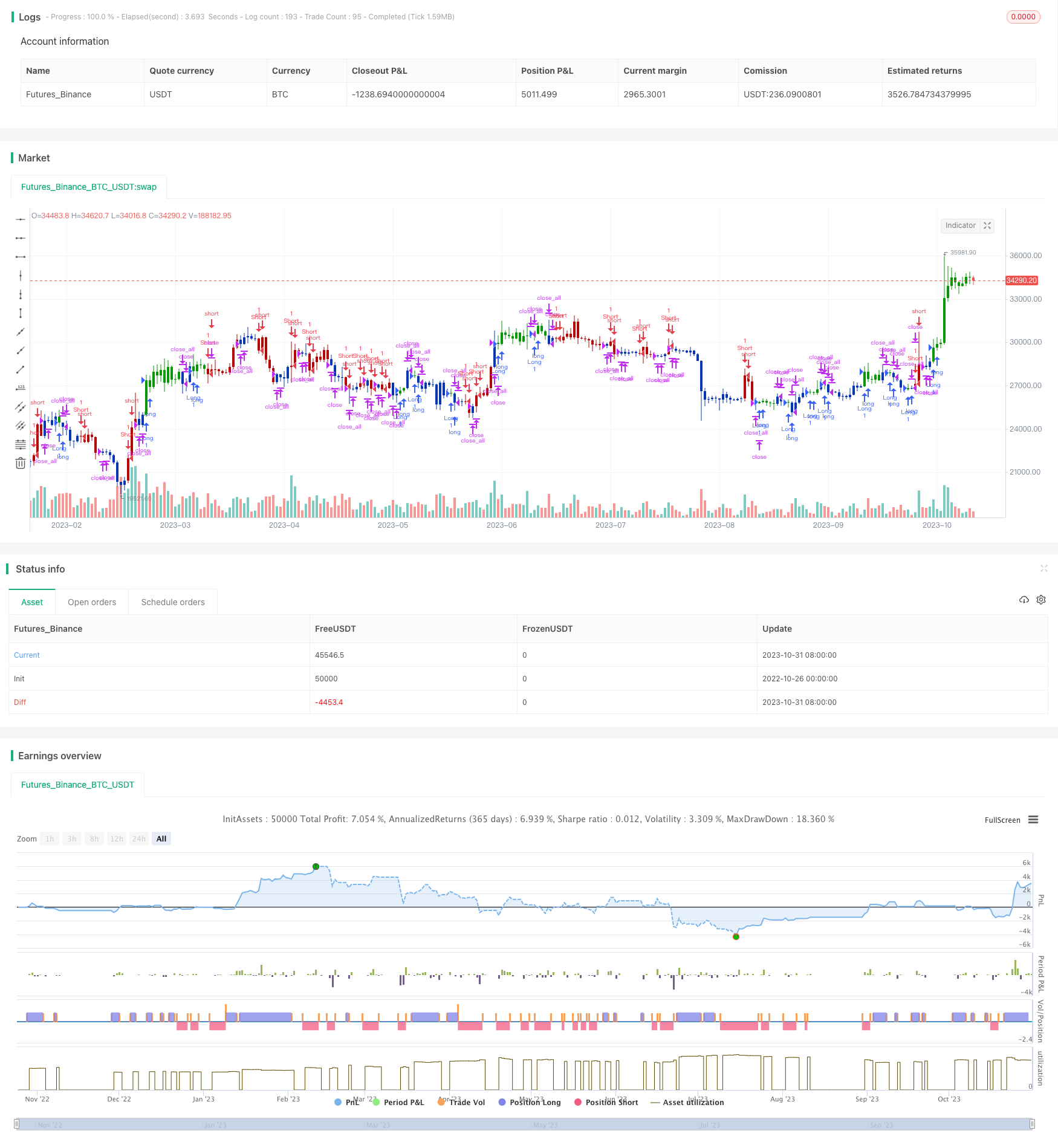
概述
该策略通过组合使用双EMA和Awesome Oscillator两个指标,实现对趋势的识别和跟踪。其中EMA快速判断近期趋势方向,Awesome Oscillator过滤假突破提供入场时机。策略名称“双信号趋势跟踪策略”可以准确概括策略的主要功能。
策略原理
该策略主要运用双EMA和Awesome Oscillator两个技术指标进行信号过滤,具体逻辑如下:
计算2周期和20周期的EMA,当2周期EMA由下向上突破20周期EMA时,判断为上涨趋势;当2周期EMA由上向下突破20周期EMA时,判断为下跌趋势。
计算Awesome Oscillator,它由快速移动平均线减去慢速移动平均线得到,再用快速移动平均线减去MACD柱状图得到柱状图。当AO柱状图由红变蓝时视为买入信号,由蓝变红则为卖出信号。
只有当EMA显示上涨趋势,且AO同时显示买入信号时,才生成最终的买入信号;只有当EMA显示下跌趋势,且AO同时显示卖出信号时,才生成最终的卖出信号。
通过该双信号过滤机制,可以有效减少假突破操作,跟踪趋势中期方向。
优势分析
该策略具有以下优势:
双线联合过滤,可以减少噪音导致的错误交易。EMA判断大趋势方向,AO过滤进场时机,二者搭配可以提高信号的可靠性。
响应 Sensitivity 极快,可以及时捕捉短期内的趋势反转。2周期EMA对突破极为敏感,可以快速判断近期内趋势是否转变。
Awesome Oscillator 对MACD进行再次滤波,可以有效识别趋势中的假突破,避免不必要的反向操作。
策略方向明确,实现对中期趋势的跟踪。EMA确定基本趋势方向,AO进一步过滤确保符合大趋势方向交易,可以持续捕捉中期趋势行情。
策略参数选择合理,2周期和20周期EMA捕捉不同周期价格变化,5周期和34周期AO参数经过优化,可以较好地识别短期内的形态特征。
风险分析
该策略也存在一些风险:
在震荡行情中,EMA和AO可能发出较多错误信号,导致不必要的空头交易。可以通过调整EMA周期参数来降低误判风险。
AO在某些情况下可能滞后EMA,导致信号发生时间差,可以适当优化AO参数,使其更快地响应突破。
兼顾短中期特征的EMA和AO参数设定,对数据质量和计算力要求较高,需要根据不同品种特点调整。
频繁交易会产生更多手续费和滑点成本。可以适当放宽策略 Exit 标准,延长持仓周期。
策略没有考虑大周期趋势和关键支撑阻力位,应组合更多因素确保交易方向正确。
优化方向
该策略可以通过以下几个方面进行优化:
引入趋势判断指标,辅助EMA判断大趋势方向,例如常用的moving average ribbons、ATR等指标补充判断。
增加关键支撑阻力位识别机制,如Fibonacci回撤线,只在关键位附近发出信号。避免不利位置建仓。
优化EMA和AO参数组合,提高两者结合效果。例如使用类遗传算法自动寻找最佳参数对。
增加止损 Exit 机制。当价格突破最近Swing High/Low时,及时止损离场,控制单笔损失。
前期数据集验证,使用历史数据测评策略效果。检验是否可以稳定盈利,回测结果是否符合预期。
实盘模拟调参,逐步调整参数提高实盘指标效果。验证参数健壮性,得到更好的稳定参数组合。
总结
本策略整体思路清晰,以EMA判断大趋势方向,AO过滤信号的组合使用两种指标进行双重验证。可以有效识别趋势,跟踪中期行情。但也存在一定的风险与不足,需要继续优化测试以提高稳定性。关键是要选择合适的品种与参数,结合交易者的风格与法则进行应用。总体来说,该策略思路合理,具有实用价值。
/*backtest
start: 2022-10-26 00:00:00
end: 2023-11-01 00:00:00
period: 1d
basePeriod: 1h
exchanges: [{"eid":"Futures_Binance","currency":"BTC_USDT"}]
*/
//@version=5
////////////////////////////////////////////////////////////
// Copyright by HPotter v1.0 27/04/2022
// This is combo strategies for get a cumulative signal.
//
// First strategy
// This indicator plots 2/20 exponential moving average. For the Mov
// Avg X 2/20 Indicator, the EMA bar will be painted when the Alert criteria is met.
//
// Second strategy
// This indicator plots the oscillator as a histogram where blue denotes
// periods suited for buying and red . for selling. If the current value
// of AO (Awesome Oscillator) is above previous, the period is considered
// suited for buying and the period is marked blue. If the AO value is not
// above previous, the period is considered suited for selling and the
// indicator marks it as red.
//
// WARNING:
// - For purpose educate only
// - This script to change bars colors.
////////////////////////////////////////////////////////////
EMA20(Length) =>
pos = 0.0
xPrice = close
xXA = ta.ema(xPrice, Length)
nHH = math.max(high, high[1])
nLL = math.min(low, low[1])
nXS = nLL > xXA or nHH < xXA ? nLL : nHH
iff_1 = nXS < close[1] ? 1 : nz(pos[1], 0)
pos := nXS > close[1] ? -1 : iff_1
pos
AC(nLengthSlow,nLengthFast,nLengthMA,nLengthEMA,nLengthWMA,bShowWMA,bShowMA,bShowEMA) =>
pos = 0.0
xSMA1_hl2 = ta.sma(hl2, nLengthFast)
xSMA2_hl2 = ta.sma(hl2, nLengthSlow)
xSMA1_SMA2 = xSMA1_hl2 - xSMA2_hl2
xSMA_hl2 = ta.sma(xSMA1_SMA2, nLengthFast)
nRes = xSMA1_SMA2 - xSMA_hl2
xResWMA = ta.wma(nRes, nLengthWMA)
xResMA = ta.sma(nRes, nLengthMA)
xResEMA = ta.ema(nRes, nLengthEMA)
xSignalSeries = bShowWMA ? xResWMA :
bShowMA ? xResMA :
bShowEMA ? xResEMA : na
pos := xSignalSeries[2] < 0 and xSignalSeries[1] > 0? 1:
xSignalSeries[2] > 0 and xSignalSeries[1] < 0 ? -1 : nz(pos[1], 0)
pos
strategy(title='Combo 2/20 EMA & Bill Awesome Oscillator (AC)', shorttitle='Combo', overlay=true)
var I1 = '●═════ 2/20 EMA ═════●'
Length = input.int(14, minval=1, group=I1)
var I2 = '●═════ Awesome Oscillator (AC) ═════●'
nLengthSlow = input.int(34, minval=1, title="Length Slow", group=I2)
nLengthFast = input.int(5, minval=1, title="Length Fast", group=I2)
nLengthMA = input.int(15, minval=1, title="MA", group=I2)
nLengthEMA = input.int(15, minval=1, title="EMA", group=I2)
nLengthWMA = input.int(15, minval=1, title="WMA", group=I2)
bShowWMA = input.bool( defval=true, title="trading WMA", group=I2)
bShowMA = input.bool( defval=false, title="trading MA", group=I2)
bShowEMA = input.bool( defval=false, title="trading EMA", group=I2)
var misc = '●═════ MISC ═════●'
reverse = input.bool(false, title='Trade reverse', group=misc)
var timePeriodHeader = '●═════ Time Start ═════●'
d = input.int(1, title='From Day', minval=1, maxval=31, group=timePeriodHeader)
m = input.int(1, title='From Month', minval=1, maxval=12, group=timePeriodHeader)
y = input.int(2005, title='From Year', minval=0, group=timePeriodHeader)
StartTrade = time > timestamp(y, m, d, 00, 00) ? true : false
posEMA20 = EMA20(Length)
prePosAC = AC(nLengthSlow,nLengthFast,nLengthMA,nLengthEMA,nLengthWMA,bShowWMA,bShowMA,bShowEMA)
iff_1 = posEMA20 == -1 and prePosAC == -1 and StartTrade ? -1 : 0
pos = posEMA20 == 1 and prePosAC == 1 and StartTrade ? 1 : iff_1
iff_2 = reverse and pos == -1 ? 1 : pos
possig = reverse and pos == 1 ? -1 : iff_2
if possig == 1
strategy.entry('Long', strategy.long)
if possig == -1
strategy.entry('Short', strategy.short)
if possig == 0
strategy.close_all()
barcolor(possig == -1 ? #b50404 : possig == 1 ? #079605 : #0536b3)